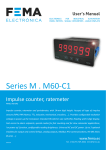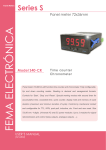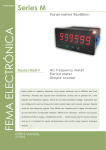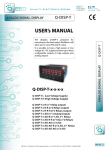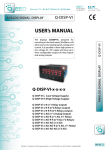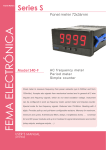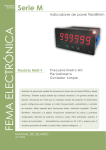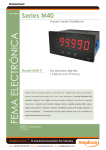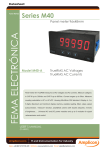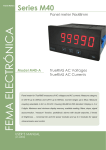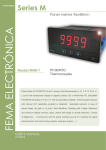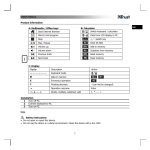Download USER's MANUAL
Transcript
eed eed quality electronic design ANALOG SIGNAL DISPLAY www.qeed.it [email protected] www.dem-it.com Q-DISP-C Q-DISP-C-x-x-x-x Q-DISP-C-L (Low Voltage Supply) Q-DISP-C-H (High Voltage Supply) ANALOG SIGNAL DISPLAY The displays Q-DISP-C, prepared for mounting on the back panel, 96x48mm, will allow you to count and totalize. It is possible to have a high power or low voltage AC / DC and have up to configurable outputs of relay outputs and analog outputs Q-DISP-C USER’s MANUAL Q-DISP-C-x-R (n°1 Relay output) Q-DISP-C-x-R-R (n°2 Relays output) Q-DISP-C-x-R-R-R (n°3 Relays output) Q-DISP-C-x-AO (n°1 Analog Output) Q-DISP-C-x-AO-R (n°1 AO, n°1 Relay) Q-DISP-C-x-AO-R-R (n°1AO, n°2 Relays) Q-DISP-C-x-AO-AO (n°2 AO) Q-DISP-C-x-AO-AO-R (n°2 AO, n°1 Relay) Q-DISP-C-x-AO-AO-AO (n°3 AO) Sept 2013 DEM SPA - Z.I. Villanova, 20 -32013 Longarone (BL) Italy - tel. +39 0437 761021 -fax +39 0437 760024 - P.Iva 00691730253 User’s Manual 1. Meter Q-DISP-C Panel meter 96x48mm counter, ratemeter, periodmeter Panel meter configurable as impulse counter, ratemeter and periodmeter. Accepts wide range of signal types such as Push-pull, NPN, PNP, Namur, TTL, inductive, mechanical, ... also monodirectional and bidirectional encoder signals (quadrature signals). Highly configurable, with pull-up/pull-down resistors, trigger levels, pulse detection on raising or falling edge, excitation voltage and antirrebound filters. ‘Trigger Sense’ utility for easy trigger level adjustment. Scalable reading by configurable multiplier and divider factors (1 to 999999). Configurable decimal point position. Resolution 6 digits (999999/-199999). Excitation voltage configurable to 5V, 9V, 15V and 18V. Up to 3 relay outputs controlled from the instrument alarms, can be increased to 6 relay outputs (with simplified functionality, see section 2). Configurable direct access to setpoint values modification on key UP (5). Standard 96x48mm DIN size. Universal AC and DC power options. Up to three control and/or signal retransmission modules. IP54 front protection, with optional IP65. Connections via plug-in screw terminals and configuration via three front push-buttons. For industrial applications. Counter modes Counter functionality allows to choose between 5 counting modes (simple counter, quadrature counter, counter with inhibit control, differential counter and counter with add/substract control). Instrument has two impulse input channels (A and B) and selectable ascending or descending counting modes. Alarm functions with ‘reset to zero’ or ‘return to preset’ create a continuous counting cycle (instrument cycles from ‘preset value’ to ‘alarm value’). Instrument provides a internal cycle counter, accessible to the operator. Memory retention in case of power loss or deactivation. When power is back again, instrument recovers the last reading and configuration. Maximum counting frequency is 250 KHz in ‘FAST’ mode. Ratemeter mode Ratemeter function allows to choose between normal ratemeter (one single input channel) or bidirectional ratemeter (quadrature ratemeter) with detection of clockwise / counterclockwise sense of turn. In ratemeter mode, the instrument counts the number of impulses during a fixed period of time, and calculates the frequency. For low frequency applications, a special ‘SLOW’ mode is available, which offers the fastest response time for low frequency applications. See section 1.13 for more information. Recursive filter ‘Average’ to stabilize unstable readings. Maximum frequency in ratemeter mode is 900KHz and minimum frequency (with ‘SLOW’ mode activated) is 0.001 Hz (1mHz). Periodmeter mode Periodmeter mode detects the signal time between impulses. For long period applications, a special ‘SLOW’ mode is available which offers the fastest response time for low frequency applications. See section 1.13 for more information. Reset function is accessible from rear terminal and front push-button. The front reset can be enabled or disabled. Configurable preset value. Alarm activation can be associated to an action : ‘reset to zero’, ‘return to preset’ or ‘no action’. Relays activation and deactivation times are independent and configurable. 1.1 Order reference Model Q-DISP - C Power - H -H -L Page 2 (85-265 Vac/dc) (11-60 Vdc and 24/48 Vac) Option1 - --- Option2 - --- Option3 - --- -R (1 relay) -R (1 relay) -R (1 relay) -AO (Analogue output) -AO (Analogue output) -AO (Analogue output) - (empty) - (empty) - (empty) Q-DISP-C User’s Manual Index 1. Meter Q-DISP-C . . . . . . . . . . . . . . . . . . . 2 1.1 Order reference . . . . . . . . . . . . . . . . . . 2 1.2 Start-up . . . . . . . . . . . . . . . . . . . . . . 3 1.3 Front view . . . . . . . . . . . . . . . . . . . . . 4 1.4 Power connections . . . . . . . . . . . . . . . . 4 1.5 Sensor configuration and connections . . . . . . 4 1.6 Rear view . . . . . . . . . . . . . . . . . . . . . 4 1.7 Signal connections . . . . . . . . . . . . . . . . 4 1.8 Technical data . . . . . . . . . . . . . . . . . . . 5 1.8 Technical data (cont.) . . . . . . . . . . . . . . . 5 1.9 Mechanical dimensions (mm) . . . . . . . . . . . 5 1.10 Configuration menu . . . . . . . . . . . . . . . 6 1.10 Configuration menu (cont.) . . . . . . . . . . . . 7 1.10.1 Menu Cnf.1 - Counter . . . . . . . . . . . . . 8 1.10.2 Menu Cnf.2 - Counter quadrature . . . . . . . . . . 8 1.10.3 Menu Cnf.3 - Counter + Inhibit . . . . . . . . . . . . 8 1.10.4 Menu Cnf.4 - Counter add/substract . . . . . . . . 8 1.10.5 Menu Cnf.5 - Counter differential . . . . . . . . . . 8 1.10.6 Menu Cnf.6 - Ratemeter . . . . . . . . . . . . 8 1.10.7 Menu Cnf.7 - Ratemeter quadrature . . . . . . . . . 9 1.10.8 Menu Cnf.8 - Periodmeter . . . . . . . . . . . 9 1.11 Default factory configuration . . . . . . . . . . . 9 1.12 Configuration menu descriptions . . . . . . . . 10 1.12.1 Function mode . . . . . . . . . . . . . . . . 10 1.12.2 Decimal point . . . . . . . . . . . . . . . . 10 1.12.3 “cnF.1” - Counter . . . . . . . . . . . . . . 10 1.12.4 “cnF.2” - Counter quadrature . . . . . . . . 10 1.12.5 “cnF.3” - Counter + Inhibit . . . . . . . . . . 10 1.12.6 “cnF.4” - Counter + Control A/S . . . . . . . . 10 1.12.7 “cnF.5” - Counter differential . . . . . . . . . 11 1.12.8 “cnF.6” - Ratemeter . . . . . . . . . . . . . . 11 1.12.9 “cnF.7” - Ratemeter quadrature . . . . . . . . 11 1.12.10 “cnF.8” - Periodmeter . . . . . . . . . . . . 11 1.12.11 Menu Sensor . . . . . . . . . . . . . . . . 12 1.12.12 Menu Alarms . . . . . . . . . . . . . . . . 12 1.12.13 Menu Tools . . . . . . . . . . . . . . . . . 13 1.12.14 Menu OptX - Options . . . . . . . . . . . . 13 1.13 Mode ‘SLOW’ . . . . . . . . . . . . . . . . . . 13 1.14 Mode ‘FAST’ . . . . . . . . . . . . . . . . . . 13 1.15 ‘Trigger Sense’ . . . . . . . . . . . . . . . . . 13 1.16 Messages and errors . . . . . . . . . . . . . . 14 1.17 Operating the menus . . . . . . . . . . . . . . 14 1.18 Accessing the instrument . . . . . . . . . . . . 14 1.19 Warranty . . . . . . . . . . . . . . . . . . . . 15 1.20 Installation precautions . . . . . . . . . . . . . 15 2. Control modules . . . . . . . . . . . . . . . . . . . 15 2.1 Module R . . . . . . . . . . . . . . . . . . . . . 15 2.2 Module AO . . . . . . . . . . . . . . . . . . . . 15 1.2 Start-up To start-up the instrument, take the following steps into consideration : 4. Select the function mode (counter, ratemeter, periodmeter, ...) and values for multiplier and divider (menu “Func”). 1. Input signal connections à see section 1.5 y 1.7 4.1. function mode à see section 1.12.1 2. Power connections 4.2. decimal point position “dP” à see section 1.12.2 à see section 1.4 3. Sensor configuration àsee section 1.12.11 (menu “SnSr”). Select from the “Auto” menu entry one of the listed sensors, to configure the default values for that sensor (values indicated in Table1 (see section 1.5)). Values can also be manually configured : 3.1. pull-up/pull-down resistors on channel A, B and Reset 3.2. trigger level (shared for channels A and B). (Trigger level for reset is fixed at 2,5V). 4.3. multipliers and dividers à see sections 1.12.3 to 1.12.10 (menu “cnF.X”) depending on the function mode selected. 5. Advanced configuration To modify setpoint values, presets, activation edges, etc ... see next sections in this document. 3.3. antirrebound filter (shared for channels A and B) 3.4. excitation voltage value Q-DISP-C Page 3 User’s Manual 1.6 Rear view 1.3 Front view Alarms Option3 Option1 Option2 Units Logo 123 45 Button ‘LE’ Button ‘UP’ Button ‘SQ’ Front reset for Quick access counter mode Signal Access to ‘Configuration menu’ 1.4 Power connections Earth connection - Although a terminal is offered for earth connection, the connection is optional. The instrument does not need this connection for correct functioning nor for compliance with the security regulations. Power 1.7 Signal connections 8 9 0 1 2 3 4 5 Fuse - To comply with security regulation 61010-1, add to the power line a protection fuse acting as disconnection element, easily accessible to the operator and identified as a protection device. ~ + ~ - Reset Channel B Channel A Power “H” fuse 250mA time-lag Vexc Power “L” fuse 400mA time-lag 0V 1.5 Sensor configuration and connections Examples of connections and configurations for different sensor types. Connections are indicated for channel A. For channel B connect the same way, but in channel B. Note - values indicated on Table1 are usual values. Confirm with your sensor datasheet the specifications that apply and adapt the configuration values and connections as needed. Connections (for channel A) Sensor Mechanical contact Namur 0V Channel A Channel A Vexc Antirrebound Trigger filter Pulls Vexc Pull-up No 100mSec. 2,5V Pull-down 9V No 3,0V NPN 2 wires 0V Channel A Pull-up 18V No 2,5V NPN 3 wires 0V Channel A Vexc Pull-up 18V No 2,5V PNP 2 wires 0V Channel A Pull-down 18V No 2,5V PNP 3 wires 0V Channel A Vexc Pull-down 18V No 2,5V Push-pull 0V Channel A Vexc No 18V No 2,5V TTL CMOS Pick-up 0V Channel A No 5V No 2,5V AC <30V Inductive 0V Channel A No No No 0V Table1 - Configuration and connections for different sensor types Examples for channel A connections Page 4 Q-DISP-C User’s Manual 1.8 Technical data Digits Type Height Display maximum Display minimum Decimal point Overrange Underrange 1.8 Technical data (cont.) 6 7 segments, red 14 mm 999999 -199999 selectable 8.8.8.8.8.8. configurable ‘flash’, ‘reset’, ‘preset’ configurable ‘flash’, ‘reset’, ‘preset’ Signals accepted Connections Signal types impulses and frequencies 2 wires, 3 wires and quadrature Push-pull, NPN, PNP, Namur, Pick-up, TTL, inductive, mechanical, quadrature, ... Maximum Vdc at input ±30Vdc Input impedance 2K4 if pull resistors on 470K if pull resistors off Maximum and minimum frequencies Counter with ‘FAST’ mode max. 250 KHz without ‘FAST’ mode max. 9 KHz Counter quadrature x1 max. 17 KHz Counter quadrature x2 max. 16 KHz Counter quadrature x4 max. 11 KHz Counter + inhibit max. 9 KHz Counter + control A/S max. 9 KHz Counter differential max. 9 KHz Ratemeter with ‘SLOW’ mode with ‘SLOW’ mode Ratemeter quadrature x1 Ratemeter quadrature x2 Ratemeter quadrature x4 max. 900 KHz max. 200Hz min. 1mHz max. 17 KHz max. 16 KHz max. 11 KHz Periodmeter with ‘SLOW’ mode with ‘SLOW’ mode max. 900 KHz max. 200 Hz min. 1mHz(1000 seconds) Accuracy Of the quartz oscillator Thermal drift ±0.01% 20ppm/ºC Excitation voltage Configurable to Current Protection 5V, 9V, 15V, 18V 70mA max. yes, current limited to 70mA max. Refresh Display refresh Number of readings Number of readings 15 / second 100 / second in counter modes 1 / GATE in rate and period modes Power Power “H” Power “L” Consumption Isolation (tested 60 seconds) 3500Veff for power “H” 2000Veff for power “L” Configuration 3 frontal push buttons (rear jumper for coupling selection) Functions available Multiplier and divider yes, configurable Preset yes, configurable Edge selection yes, configurable ‘SLOW’ frequency mode yes, configurable Recursive filter yes, configurable Pull resistors yes, configurable Trigger levels yes, configurable Excitation voltage yes, configurable Antirrebound filter yes, configurable Memory yes, maximum ,minimum, cycles Memory of counter yes, recovers data on power loss Reset configurable yes, front and/or rear reset and/or assigned to setpoint Zeros to the left yes, configurable Password yes, configurable Brightness control yes, 5 levels Optional boards maximum 3 (see section 2) Mechanical Mounting Connections Weight Housing materials Front size Panel cut-out Deep from panel panel plug-in screw terminals <150 grams ABS, polycarbonate 96x48mm 92x44mm 91mm (including terminal) Protection IP54 standard IP65 optional (Front sealed. Opening the front breaks the seal) Temperature Operation 0 to 50ºC Temperature Storage –20 to +70ºC Warm-up 15 minutes 1.9 Mechanical dimensions (mm) 48 96 44 85 to 265 Vac/dc 11 to 60 Vdc and 24/48Vac <4W 16 75 8 Panel cut-out 92 Q-DISP-C Page 5 User’s Manual 1.10 Configuration menu Press ‘SQ’ button (<) to enter ‘Configuration Menu’ Explanation on each menu entry starts at section 1.13 No pull Pulls - channel B Counter Function Counter quadrature Pull Up Pull Down Counter + inhibit Counter + control add / substract No pull Pulls - reset Counter differential Ratemeter Pull Up Pull Down Ratemeter quadrature Periodmeter Trigger Press LE (3) to change selection Decimal point Configuration Counter or or ... or Config. Counter Config. quadrature Periodmeter Menu shows only “cnF.x” for the selected function. See sections 1.11.1 to 1.11.8 for an explanation on each menu entry. by rising edge Activation channel A Mechanical contact Sensor Auto config. Trigger level (from 0.0Vdc to 3.9Vdc). See section 1.15 for ‘Trigger Sensor’ utility. by falling edge by rising edge Activation reset Namur by falling edge NPN 2 wires NPN 3 wires Excitation voltage PNP 2 wires PNP 3 wires Push pull TTL CMOS Pick-up Antirrebound Antirrebound filter (0 to 1000mSec.) Inductive Vac <30V Alarms Al. active No pull Pulls - channel A Alarm1 Pull Up Al. inactive Al. as maximum Pull Down Page 6 Active Alarm type Q-DISP-C Al. as minimum User’s Manual 1.10 Configuration menu (cont.) Setpoint Setpoint2 Setpoint Hysteresis Hysteresis Setpoint3 Delay0 Delay on relay activation (in seconds) Delay1 Delay on relay deactivation (in seconds) Front reset Second setpoint Counter overrange Flash Setpoint2 To preset Continue On alarm To zero To zero Flash To preset Counter underrange To zero To preset Menu for Alarm2 With left zeros Menu for Alarm3 Left Zeros Value Tools Memory of maximum Password Max. memory reset Value Memory of minimum Factory configuration Min. memory reset Without left zeros Password 6 digits Apply Firmware version Value Memory of cycles Version Cycle memory reset Minimum Brightness Key UP See Cycles See Max. Maximum Menu for optional module at ‘Opt1’ Option1 Menu for optional module at ‘Opt2’ See Min. Option2 Menu for optional module at ‘Opt3’ Setpoint1 Option3 Q-DISP-C Page 7 User’s Manual 1.10.1 Menu Cnf.1 - Counter Configuration Counter Multiplier Divider Preset 1.10.4 Menu Cnf.4 - Counter add/substract Multiplier 1 to 999999 Divider 1 to 999999 Configuration Counter + Control add / substract Multiplier Divider Preset value -199999 to 999999 Preset Up counter Mode ‘FAST’ mode Configuration Counter quadrature Divider Preset Configuration Counter differential Multiplier 1 to 999999 Divider Divider 1 to 999999 Preset value -199999 to 999999 Multiplier Preset Preset value -199999 to 999999 Adds if channel B is at ‘1’ Adds if channel B is at ‘0’ 2 imp. per cycle 4 imp. per cycle Multiplier 1 to 999999 Divider 1 to 999999 Preset value -199999 to 999999 1.10.6 Menu Cnf.6 - Ratemeter 1 imp. per cycle Steps Divider 1 to 999999 1.10.5 Menu Cnf.5 - Counter differential 1.10.2 Menu Cnf.2 - Counter quadrature Multiplier Control A/S Down counter Multiplier 1 to 999999 Configuration Ratemeter Multiplier Divider Multiplier 1 to 999999 Divider 1 to 999999 Seconds Time gate 1.10.3 Menu Cnf.3 - Counter + Inhibit Configuration Counter + Inhibit Multiplier Divider Preset Multiplier 1 to 999999 Divider 1 to 999999 Preset value -199999 to 999999 Up counter Mode Inhibit Page 8 ‘SLOW’ mode max. wait time 1 to 1000 Sec. Average Filter value from 0.0 to 99.9 Down counter Active if channel B is at ‘1’ Active if channel B is at ‘0’ Q-DISP-C User’s Manual 1.10.7 Menu Cnf.7 - Ratemeter quadrature Configuration Ratemeter quadrature Multiplier Divider Multiplier 1 to 999999 Function (“Func”) Decimal point (“dP”) counter (“cn.1”) no Divider 1 to 999999 Counter configuration (“cnF.1”) Multiplier (“Mult”) Divider (“dIV”) Preset (“PrSt”) Mode (“ModE”) ‘FAST’ (“FASt”) x1 /1 0 up counter (“uP”) off (“oFF”) Sensor (“SnSr”) Pull channel A (“PuL.A”) Pull channel B (“PuL.b”) Pull reset (“PuL.r”) Trigger (“trIG”) Activation channel A (“Act.A”) Activation reset (“Act.r”) Excitation voltage(“V.EXc”) Antirrebound filter no pull (“no”) no pull (“no”) pull-up (“P.uP”) 2,5Vdc rising edge (“on_h”) rising edge (“on_h”) 15Vdc 0 mSeconds Seconds Time gate 1 imp. per cycle Steps 2 imp. per cycle 4 imp. per cycle Average Filter value from 0.0 to 99.9 1.10.8 Menu Cnf.8 - Periodmeter Configuration Periodmeter Multiplier Divider Multiplier 1 to 999999 Divider 1 to 999999 Seconds Time gate ‘SLOW’ mode Average 1.11 Default factory configuration Tools (“tooL”) Memory of maximum Memory of minimum Memory of cycles Key UP (“K.uP”) Cycles Maximum Minimum Alarm1 setpoint Alarm2 setpoint Alarm3 setpoint Front reset (“F.rSt”) Counter overrange Counter underrange Left zeros Password Brightness Alarms 1,2 and 3 Active Type Setpoint Hysteresis Activation delay (“dEL.0”) Deactivation delay (“dEL.1”) Setpoint2 On Alarm max. wait time 1 to 1000 Sec. Filter value from 0.0 to 99.9 -199999 999999 0 Off Off Off Off Off Off On Flash (“FLSh”) Flash (“FLSh”) Off Off 3 Off (disabled) maximum alarm 1000 0 counts 0.0 seconds 0.0 seconds Off continue Ratemeter (“cnF.6”) and Periodmeter (“cnF.8”) configuration Multiplier (“Mult”) x1 Divider (“dIV”) /1 Time gate (“GAtE”) 0.5 seconds ‘SLOW’ mode (“SLoW”) Off Recursive filter (“AVr”) Off Q-DISP-C Page 9 User’s Manual 1.12 Configuration menu descriptions 1.12.1 Function mode 1.12.4 “cnF.2” - Counter quadrature Select de function of the instrument. “cn.1” - Counter - Input impulses on channel A. Channel B disabled. “cnq.2” - Counter for quadrature signals - Input impulses in quadrature (bidirectional encoder) on channels A and B. “cnI.3” - Counter + inhibit control - Input impulses on channel A. Inhibition control inhibit on channel B. “cnc.4” - Counter + control add / substract- Input impulses on channel A. Control for function add or substract, on channel B. “cnd.5” - Counter differential - Input impulses with add function on channel A. Input impulses with substract function on channel B. “rt.6” - Ratemeter - Input impulses on channel A. Channel B disabled. “rtq.7” - Ratemeter for quadrature signals - Input impulses in quadrature (bidirectional encoder) on channels A and B. The “cnF.2” menu is visible only when function mode “cnq.2” ‘counter quadrature’ is selected. Impulses received are internally counted, multiplied by the “MuLt” parameter, divided by the “dIV” parameter, and the result is updated on display. Multiplier (“MuLt”) - Value from 1 to 999999. Multiplier factor to be applied to the total number of impulses counted. Divider (“dIV”) - Value from 1 to 999999. Divider factor to be applied to the total number of impulses counted. Preset (“PrSt”) - Value from 999999 to -199999. Reset activation loads on display the preset value. Edges (“q.124”) - Value “1--1”, “1--2” or “1--4”. Select “1-1” to count 1 impulse per quadrature cycle. Select “1--2” to count 2 impulses per quadrature cycle. Select “1--4” to count 4 impulses per quadrature cycle. 1.12.5 “cnF.3” - Counter + Inhibit “Prd.8” - Periodmeter - Input impulses on channel A. Channel B disabled. The “cnF.3” menu is visible only when function mode “cnI.3” ‘counter + inhibit’ is selected. Impulses received are internally counted, multiplied by the “MuLt” parameter, divided by the “dIV” parameter, and the result is updated on display. The selected function (“Func”) modifies the configuration menu (“cnF.x”) presented by the instrument. Multiplier (“MuLt”) - Value from 1 to 999999. Multiplier factor to be applied to the total number of impulses counted. 1.12.2 Decimal point Select the position for the decimal point. Modify with the LE button and validate with the SQ button. 1.12.3 “cnF.1” - Counter The “cnF.1” menu is visible only when function mode “cn.1” ‘counter’ is selected. Impulses received are internally counted, multiplied by the “MuLt” parameter, divided by the “dIV” parameter, and the result is updated on display. Multiplier (“MuLt”) - Value from 1 to 999999. Multiplier factor to be applied to the total number of impulses counted. Divider (“dIV”) - Value from 1 to 999999. Divider factor to be applied to the total number of impulses counted. Preset (“PrSt”) - Value from 999999 to -199999. Reset activation loads on display the preset value. Mode (“ModE”) - Value “uP” / “doWn”. Select “uP” for up counter (received impulses add). Select “doWn” for down counter (impulses received substract). ‘FAST’ mode (“FASt”) - Value “on” / “oFF”. See section 1.14 Divider (“dIV”) - Value from 1 to 999999. Divider factor to be applied to the total number of impulses counted. Preset (“PrSt”) - Value from 999999 to -199999. Reset activation loads on display the preset value. Mode (“ModE”) - Value “uP” / “doWn”. Select “uP” for up counter (received impulses add). Select “doWn” for down counter (impulses received substract). Inhibit (“Inh”) - Value “on_h” / “on_0”. Select “on_h” to inhibit counting when channel B is at logic state ‘1’. Select “on_0” to inhibit counting when channel B is at logic state ‘0’. 1.12.6 “cnF.4” - Counter + Control A/S The “cnF.4” menu is visible only when function mode “cnc.4” ‘counter + control add / substract’ is selected. Impulses received are internally counted, multiplied by the “MuLt” parameter, divided by the “dIV” parameter, and the result is updated on display. Multiplier (“MuLt”) - Value from 1 to 999999. Multiplier factor to be applied to the total number of impulses counted. Divider (“dIV”) - Value from 1 to 999999. Divider factor to be applied to the total number of impulses counted. Preset (“PrSt”) - Value from 999999 to -199999. Reset activation loads on display the preset value. Page 10 Q-DISP-C User’s Manual Control A/S (“Add”) - Value “on_h” / “on_0”. Select “on_h” to add the impulses received on channel A when channel B is at logic state ‘1’ (impulses received on channel A are substracted if channel B is at logic state ‘0’). Select “on_0” to add the impulses received on channel A when channel B is at logic state ‘0’ (impulses received on channel A are substracted if channel B is at logic state ‘1’). 1.12.7 “cnF.5” - Counter differential The “cnF.5” menu is visible only when function mode “cnd.5” ‘counter differential’ is selected. Impulses received are internally counted, multiplied by the “MuLt” parameter, divided by the “dIV” parameter, and the result is updated on display. Impulses received on channel A always add. Impulses received on channel B always substract. Multiplier (“MuLt”) - Value from 1 to 999999. Multiplier factor to be applied to the total number of impulses counted. Divider (“dIV”) - Value from 1 to 999999. Divider factor to be applied to the total number of impulses counted. Preset (“PrSt”) - Value from 999999 to -199999. Reset activation loads on display the preset value. 1.12.9 “cnF.7” - Ratemeter quadrature The “cnF.7” menu is visible only when function mode “rtq.7” ‘ratemeter quadrature’ is selected. Based on the number of impulses received during the time window defined at the “GAtE” parameter, frequency is calculated (impulses received / ‘GATE’). The frequency value obtained is multiplied by the “MuLt” parameter, divided by the “dIV” parameter, and the result is updated on display. Value on display is updated every X seconds (X value defined at the “GAtE” parameter). Multiplier (“MuLt”) - Value from 1 to 999999. Multiplier factor to be applied to the total number of impulses counted. Divider (“dIV”) - Value from 1 to 999999. Divider factor to be applied to the total number of impulses counted. Time window (“GAtE”) - Selectable 0.5, 1.0, 2.0, 4.0, 8.0 and 16.0 seconds. Time window to count received impulses and calculate the frequency. Edges (“q.124”) - Value “1--1”, “1--2” o “1--4”. Select “1-1” to count 1 impulse per quadrature cycle. Select “1--2” to count 2 impulses per quadrature cycle. Select “1--4” to count 4 impulses per quadrature cycle. Average (AVR) - Value from “0.0” to “99.9”. Recursive filter. The severity of the filter increases with the value selected. 1.12.8 “cnF.6” - Ratemeter The “cnF.6” menu is visible only when function mode “rt.6” ‘ratemeter’ is selected. Based on the number of impulses received during the time window defined at the “GAtE” parameter, frequency is calculated (impulses received / ‘GATE’). The frequency value obtained is multiplied by the “MuLt” parameter, divided by the “dIV” parameter, and the result is updated on display. Value on display is updated every X seconds (X value defined at the “GAtE” parameter). Multiplier (“MuLt”) - Value from 1 to 999999. Multiplier factor to be applied to the total number of impulses counted. Divider (“dIV”) - Value from 1 to 999999. Divider factor to be applied to the total number of impulses counted. Time window (“GAtE”) - Selectable 0.5, 1.0, 2.0, 4.0, 8.0 and 16.0 seconds. Time window to count received impulses and calculate the frequency. Inactive if ‘SLOW’ mode is active. ‘SLOW’ mode (“SLoW”) - Selectable “on” / “oFF”. Select “on” to activate and define the value for parameter ‘Max. waiting time’ between 1 and 1000 seconds. See section 1.13 for more information on ‘SLOW’ mode. ‘SLOW’ mode disables the value selected at “GAtE”. Average (AVR) - Value from “0.0” to “99.9”. Recursive filter. The severity of the filter increases with the value selected. 1.12.10 “cnF.8” - Periodmeter The “cnF.8” menu is visible only when function mode “Prd.8” ‘periodmeter’ is selected. Based on the number of impulses received during the time window defined at the “GAtE” parameter, period is calculated (‘GATE’ / impulses received ). The period value obtained is multiplied by the “MuLt” parameter, divided by the “dIV” parameter, and the result is updated on display. Value on display is updated every X seconds (X value defined at the “GAtE” parameter). Multiplier (“MuLt”) - Value from 1 to 999999. Multiplier factor to be applied to the total number of impulses counted. Divider (“dIV”) - Value from 1 to 999999. Divider factor to be applied to the total number of impulses counted. Time window (“GAtE”) - Selectable 0.5, 1.0, 2.0, 4.0, 8.0 and 16.0 seconds. Time window to count received impulses and calculate the frequency. Inactive if ‘SLOW’ mode is active. ‘SLOW’ mode (“SLoW”) - Selectable “on” / “oFF”. Select “on” to activate and define the value for parameter ‘Max. waiting time’ between 1 and 1000 seconds. See section 1.13 for more information on ‘SLOW’ mode. ‘SLOW’ mode disables the value selected at “GAtE”. Average (AVR) - Value from “0.0” to “99.9”. Recursive filter. The severity of the filter increases with the value selected. Q-DISP-C Page 11 User’s Manual 1.12.11 Menu Sensor 1.12.12 Menu Alarms Configures the input channels to recognize impulses from sensors connected on channels A, B and reset. Automatic sensor configuration (“Auto”) - Select the type of sensor to automatically configure sensor parameters as shown on Table1 (section 1.5). Configured parameters are: pull resistors, excitation voltage, antirrebound filter and trigger level. Parameters can be changed on each parameter menu entry. The list of predefined sensors are : mechanical contact (“MEch”), namur (“nAMr”), NPN 2 wires (“nPn.2”), NPN 3 wires (“nPn.3”), PNP 2 wires (“PnP.2”), PNP 3 wires (“PnP.3”), push-pull (“Ph.PL”), TTL (“ttL”), CMOS (“cMoS”), pick-up (“Pk.uP”) inductive (“Ind”) and AC signals <30Vdc (“Ac”). Pulls on channel A (“PuL.A”) - Value “no”, “P.uP” o “P.dn”. Select “P.uP” to activate the pull-up resistor on channel A. Select “P.dn” to activate the pull-down resistor on channel A. Select “no” to deactivate pulls on channel A. Trigger is automatically set to 2,5V when “P.uP” or “P.dn” are selected. Pulls on channel A (“PuL.b”) - See previous entry ‘Pulls on channel A’. Pulls del reset (“PuL.r”) - See previous entry ‘Pulls on channel A’. Trigger value for reset channel is fixed at 2,5V. Trigger (“trIG”) - Values from 0,0V to 3,9V. Select the trigger value. The input signal is considered to be a logical ‘1’ when the input signal value is higher than the trigger value (in Vdc). The input signal is considered to be a logical ‘0’ when the input signal value is lower than the trigger value (in Vdc). Trigger value is the same for channels A and B. Trigger value for reset channel is fixed at 2,5V. See section 1.15 for ‘Trigger Sensor’ utility. Activation for channel A (“Act.A”) - Value “on_h” / “on_0”. Select “on_h” to enable detection of impulses on channel A by rising edge. Select “on_0” to enable detection of impulses on channel A by falling edge. Activation for reset (“Act.r”) - Value “on_h” / “on_0”. Select “on_h” to enable reset activation by rising edge. Select “on_0” to enable reset activation by falling edge. Excitation voltage (“V.Exc”) - Select value for excitation voltage to power-up the transducer, between 5V, 9V, 15V and 18V. Select “no” to disable excitation voltage. Configuration menu for 3 alarms that control relays R1 (see section 2.1) installable at slots ‘Opt1’, ‘Opt2’ and ‘Opt3’. (Special modules R2, R4 and R6 allow for up to 6 simple relay outputs. See section 2.3 for more information). Active (“ACt”) - Value “on” / “oFF”. Defines if the instrument has to manage this alarm or not. Select “oFF” for alarm not managed. Type (“tYPE”) - Value “MAX” / “MIn”. Defines the behavior of the alarm as maximum or minimum alarm. The alarms configured as maximum are activated when the display value is equal or higher than the setpoint. The alarms configured as maximum are deactivated when the display is lower than the setpoint. The alarms configured as minimum have the inverse behavior. Setpoint (“SEt”) - Value from “999999” to “-199999”. Alarm setpoint. Hysteresis (“hYSt”) - Value from “0” to “999999”. Counts of hysteresis. The hysteresis applies on the deactivation of the alarm. Delay 0 (“dEL.0”) - Value from “0.0” to “99.9” seconds. Activation delay for relays R1. Relays and front led are activated X seconds after alarm activation. Delay 1 (“dEL.1”) - Value from “0.0” to “99.9” seconds. Deactivation delay for relays R1. Relays and front led are deactivated X seconds after alarm deactivation. Setpoint2 (“SEt2”) - Value from “-199999” to “999999”. Second setpoint. The second setpoint allows for the creation of activation windows. If the alarm is configured as maximum with setpoint 1000 and setpoint2 is configured at 1500, the alarm will be activated between 1000 and 1500 and the alarm will be deactivated when display is <1000 and >1500. Setpoint2 is affected on the same way as the setpoint with hysteresis and delays. On Alarm (“on.AL”) - Value “cont”,“to_0” or “to_p”. Behavior when the display reaches the setpoint value. Applies only to counter modes. Select “cont” to continue counting. Select “to_0” to reset display to ‘0’. Select “to_p” to jump display to preset value. Selection of “to_0” or “to_p”, configures “dEL.1” by default to 1 second. Antirrebound filter (“rbnd”) - Antirrebound filter. Selectable from 0 to 1000 mSeconds. For mechanical contact sensors set value at 100mSeconds. When an impulse is received, the filter activates and no new impulses are counted for the duration of the filter value. When the filter time is over, next impulse received is counted and filter activates again. Page 12 Q-DISP-C User’s Manual 1.12.14 Menu OptX - Options 1.12.13 Menu Tools Configuration of non usual parameters and special tools. Maximum (“MAX”) - Maximum memory value and memory reset function. Minimum (“MIn”) - Minimum memory value and memory reset function. Cycles (“cYcL”) - Cycle memory value and memory reset function. Key UP (“K.uP”) - Configuration of information accessible from key UP (5). Select “on” to activate desired entries. Pressing key UP (while in normal working mode), will visualize each one of the parameters selected. “cYcL” - Visualization of number of cycles “MAX” - Visualization of memory of maximum “MIn” - Visualization of memory of minimum “ALr1” - Visualization and modification of setpoint1 value “ALr2” - Visualization and modification of setpoint2 value “ALr3” - Visualization and modification of setpoint3 value Front reset (“F.rSt”) - Value“on” / “oFF”. Select “on” to activate reset when pressing front key LE (3). Select “oFF” to disable front reset (pressing LE key will make no function). Counter overrange (“c.orG”) - Defines the function to activate in case of counter overrange (display is higher than 999999). Select “FLSh” to set display in flash mode. Select “to_0” to reset display to ‘0’. Select “to_p” to jump display to preset value. Counter underrange (“c.urG”) - Defines the function to activate in case of counter underrange (display is lower than -199999). Select “FLSh” to set display in flash mode. Select “to_0” to reset display to ‘0’. Select “to_p” to jump display to preset value. Left Zero (“LZEr”) - Value “On/Off”. Select “On” to visualize zeros to the left. Password (“PASS”) - Select a 6 digit number to act as password. This password will be requested when entering the ‘Configuration Menu’ (key SQ <). To deactivate the password select “oFF”. Factory configuration (“FAct”) - Factory default configuration. Select “yES” to activate the factory default configuration. Menu entries “oPt1”, “oPt2” y “oPt3” give access to the configuration menus for the optional modules installed on slots ‘Opt1’, ‘Opt2’ y ‘Opt3’. This menu depends on the installed option. If there is no option installed the instrument shows “nonE”. Relay modules ‘R1’ are controlled from the standard alarm menu (see section 1.12.12). 1.13 Mode ‘SLOW’ Optional mode available in Ratemeter (“rt.6”) and Periodmeter (“Prd.8”) modes. Activate the ‘SLOW’ mode enables the fastest response time for low frequency applications. In this mode, the frequency and period calculation is calculated directly by measuring the time between two consecutive impulses. The measure is updated each time a new impulse is received. The ‘SLOW’ mode needs the user to define the parameter ‘maximum waiting time’ between impulses (with a value between 1 and 1000 seconds). If the configured time is gone with no impulses received, the frequency value is set to ‘0’ (period value is also set to ‘0’). Parameter ‘GAtE’ has no application in this mode. The ‘SLOW’ mode is functional for frequencies below 200Hz. 1.14 Mode ‘FAST’ Optional mode available in Counter mode (“cn.1”). Activate the ‘FAST’ mode enables a higher frequency input detection rate on channel A, up to 250KHz, for simple counter “cn.1” mode only. The activation of ‘FAST’ mode has the following restrictions : impulse detection edge is fixed to ‘raising edge’, and the first edge (raising or falling edge) received after a power-up (or configuration change) is not detected as impulse but will be used for internal initialization. 1.15 ‘Trigger Sense’ The ‘Trigger Sense’ provides information on the input signal state, while adjusting the trigger level. The ‘trigger’ menu (“<” / “SnSr” / “trIG”), displays the actual value of the trigger level (in Vdc) and two leds to the left named ‘up’ led and ‘down’ led. Led ‘up’ Version (“VEr”) - Firmware version installed.. Led ‘down’ Light (“LIGh”) - Brightness. Select between 5 predefined levels of brightness. Input signal at a ‘high level’ state is represented by the activation of the ‘up’ led. Input signal at a ‘low level’ state is represented by the activation of the ‘down’ led. For a correct trigger configuration, modify the trigger level until both ‘up’ and ‘down’ leds are being alternatively activated. This alternative activation state indicates that the instrument is correctly detecting the ‘1’ and ‘0’ input signal states. Q-DISP-C Page 13 User’s Manual 1.16 Messages and errors 1.18 Accessing the instrument The instrument can display the following messages and errors. “Err.1” Password entered is not correct. “Err.2” The instrument has detected an installed option but was unable to communicate. “Err.8” The instrument is limiting the current at Vexc. “999999”+ flash. The display is in overrange (real display should be higher than 999999 and can not be displayed). “-199999” + flash. The display is in underrange (real display should be lower than -199999 and can not be displayed). “E.101” Option is installed but the type can not be recognized. 1.17 Operating the menus The instrument has two menus accessible to the user : ‘Configuration menu’ (key SQ) (<) ‘Quick access menu’ (key UP) (5) You may need to access the inside of the instrument to insert additional modules. Use a flat screwdriver to unlock the upper clips marked with “A”. Then unlock the lower clips marked with “B” and remove the front cover. Let the inside of the instrument slide out of the housing. To reinsert the instrument make sure that all modules are correctly connected to the pins on the display module. Place all the set into the housing, assuring that the modules correctly fit into the internal guiding slides of the housing. Once introduced, place again the front cover by clipping first the upper clips “A” and then the lower clips “B”. Important - If your instrument was delivered with the IP65 front seal option, accessing the inside of the instrument will permanently break the IP65 seal on the areas of clips “A” and “B”. A The ‘configuration menu’ allows to change the configuration of the instrument. Access to the ‘configuration menu’ can be protected enabling the ‘PASSWORD’ function. During operation with the ‘configuration menu’ the alarms are kept ‘on-hold’. When leaving the ‘configuration menu’ the instrument performs a restart, and new configuration is applied. On restart of the instrument, also the optional modules are restarted (relays, analogue outputs, ...). The ‘quick access menu’ is a configurable menu where the user can configure access to the following information : memory values for maximum, minimum and cycles, and setpoint values for alarms 1, 2 and 3. The list of configurable parameters is accessible at “tooL” / “k.uP”. Alarm setpoints can be modified when enabled in the ‘quick access menu’. the ‘PASSWORD’ function does not block access to the ‘quick access menu’. While working in the ‘quick access menu’ the instrument keeps working as normal the background. There is no reset when leaving the ‘quick access menu’. Rollback - After 30 seconds without interaction from the operator, the instrument leaves the active menu and returns normal working mode. All changes are discarded. Key SQ (<) - Selects the menu entry currently displayed. When entering a numeric value (for example a setpoint value) validates the value on display. Key UP (5) - Moves vertically on the menu entries. When entering a numeric value (for example a setpoint value) modifies the current digit by increasing its value up from 0 to 1, 2, 3, 4, 5, 6, 7, 8, 9. Key LE (3) - Leaves the current menu. Pressing LE several times will leave all menus. When leaving all menus in the configuration menu, changes will be saved . When entering a numeric value (for example a setpoint value) it moves from one digit to the next. Each digit value can then be modified with the UP button. Page 14 Q-DISP-C B Risk of electric shock. Removing the front cover will grant access to the internal circuits. Disconnect the input signal to prevent electric shock to the operator. Operation must be performed by qualified personnel only. User’s Manual 1.19 Warranty All instruments are warranted against all manufacturing defects for a period of 24 MONTHS from the shipment date. This warranty does not apply in case of misuse, accident or manipulation by non-authorized personnel. In case of malfunction get in contact with your local provider to arrange for repair. Within the warranty period and after examination by the manufacturer, the unit will be repaired or substituted when found to be defective. The scope of this warranty is limited to the repair cost of the instrument, not being the manufacturer eligible for responsibility on additional damages or costs. . 2. Control modules 2.1 Module R Module with 1 relay. Up to a maximum of three R modules can be installed in one Q-DISP panel meter. Relay type Maximum current Voltage Installable at 3 contacts (Common, NC, NO) 8A (resistive load) 250 Vac continuously Option1 and/or Option2 and/or Option3 1.20 Installation precautions Instrument protected with double isolation. No earth connection required. A B C Opt 3 Risk of electrical shock. Instrument terminals can be connected to dangerous voltage. Instrument is in conformity with CE rules and regulations. See “CE Declaration of Conformity” further in this document. The instrument does not have a general switch and will start operation as soon as power is connected. The instrument does not have protection fuse, the fuse must be added during installation. The instrument is designed to be panel mounted. An appropriate ventilation of the instrument must be assured. Do not expose the instrument to excess of humidity. Maintain clean by using a humid rag and do NOT use abrasive products such as alcohols, solvents, etc. Terminal A Terminal B Terminal C Common NO - Normally Open NC - Normally Closed Module with 1 analogue output. Configurable 4/20mA or 0/10Vdc. Output signal proportional to the reading. Scaling through the frontal keypad. Up to a maximum of three AO modules can be installed in one Q-ISP panel meter. Output Accuracy Isolated Thermal drift Installable at General recommendations for electrical installations apply, and for proper functionality we recommend : if possible, install the instrument far from electrical noise or magnetic field generators such as power relays, electrical motors, speed variators, ... If possible, do not install along the same conduits power cables (power, motor controllers, electrovalves, ...) together with signal and/or control cables. Before proceeding to the power connection, verify that the voltage level available matches the power levels indicated in the label on the instrument. In case of fire, disconnect the instrument from the power line, fire alarm according to local rules, disconnect the air conditioning, attack fire with carbonic snow, never with water. Q-DISP-C 4/20mA, 0/10Vdc selectable 0.1% FS yes, 1000Vdc 50 ppm/ºC for Vdc 60 ppm/ºC for mA Option1 and/or Option2 and/or Option3 Opt 1 MV A B C MV A B C Installation of this instrument must be performed by qualified personnel only. This manual contains the appropriate information for the installation. Using the instrument in ways not specified by the manufacturer may lead to a reduction on the specified protection level. Disconnect the instrument from power before starting any maintenance and / or installation action. Opt 2 A B C 2.2 Module AO Opt 3 This instrument has been designed and verified according to the 61010-1 CE security regulation, and is designed for applications on industrial environments. See the “CE Declaration of Conformity” further in this document for information on the category of measure and the degree of pollution levels that apply. Opt 1 A B C Opt 2 MV A B C Jumper M Jumper V mode mA mode Vdc Terminal A Terminal B Terminal C Vexc (+13.8Vdc @25mA) Signal output (mA or Vdc) GND Page 15 w w w. q e e d. i t i n fo @ qeed.i t S a les d e p ar t m ent. . . . . . . . . . . . . sa l es@ qeed.it Te ch n i cal d e p a r t m ent. . . . . . . tec hn ic a l @ qeed.it Z.I. Villanova, 20 - 32013 Longarone (BL), I taly Ph. +39 0437 761021 Fax +39 0437 760024 September 2013
















